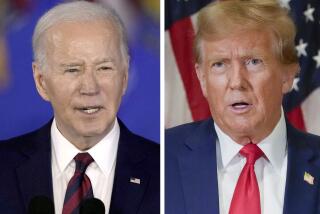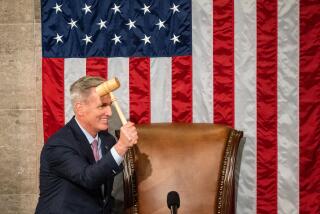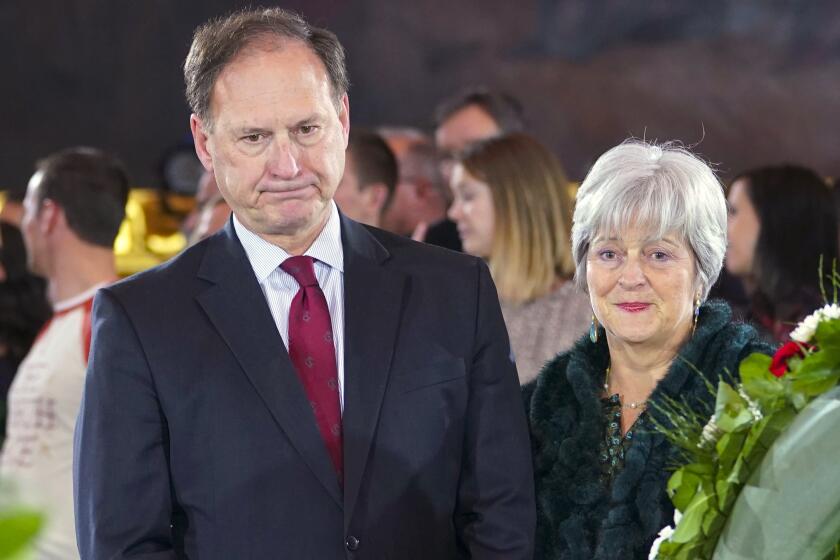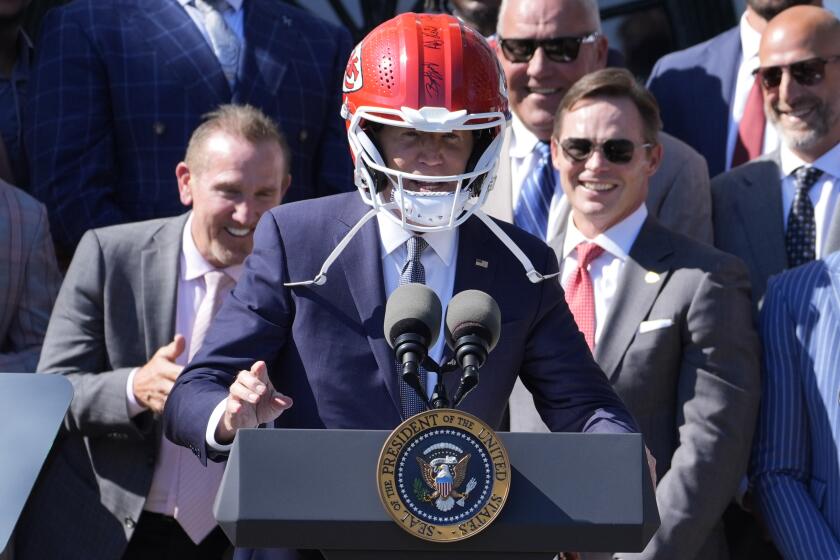CALIFORNIA ELECTIONS : Senate Hopefuls Lead Nation in Race for Cash : Politics: Candidates raise $28 million despite weak economy. Feinstein and Boxer lead GOP opponents in funding, but Seymour and Herschensohn are gaining with party boost.
California’s four U.S. Senate candidates have raised more than $28 million in contributions from constituents and special interests with much at stake in next week’s elections.
Gun owners, real estate interests and big business are fueling the campaigns of Republicans Bruce Herschensohn and John Seymour, while organized labor, women and Hollywood are lining up behind Democrats Barbara Boxer and Dianne Feinstein.
The money generated to finance each of the two Senate races in California this year is more than any congressional race in the country to date. But the two contests will cost considerably less than political experts had predicted. Fund-raisers blame California’s deep recession and stiff competition from the presidential campaign and other state races for draining the pool of political donors.
“There’s a recession out there,” said Richard McBride, Seymour’s campaign manager. “People are unemployed. The economy is horrible. Those contributors who are out there who have given in the past have to cut back like everybody else.”
Boxer and Herschensohn are running for the six-year seat to replace retiring Sen. Alan Cranston. Feinstein and Seymour are vying for the two-year seat vacated last year by Gov. Pete Wilson.
Heading into the final week of frenzied campaigning before the Nov. 3 election, Boxer and Feinstein are the leading fund-raisers, even as the races are tightening.
But in an infusion of unrestricted cash that probably will equalize the money wars, Herschensohn and Seymour each expect to receive $2.5 million from the Republican Party.
Reflecting his conservative ideology, Herschensohn has received hundreds of thousands of dollars from groups that include gun owners, religious fundamentalists, former colleagues in the Richard M. Nixon Administration and conservatives led by Sen. Jesse Helms (R-N.C.).
Like Herschensohn, Seymour has garnered his share of aerospace, oil and gun money, but has received virtually no funds from anti-abortion groups or the religious right because of his abortion rights position.
Agriculture and real estate, two industries whose interests Seymour has promoted tirelessly on Capitol Hill, are his campaign’s richest sources of cash. Individual and PAC contributors for these industries have funneled about $1 million to Seymour’s campaign.
At the same time that feminist groups are raising unprecedented amounts for them in the “Year of the Woman,” Boxer and Feinstein are relying heavily on the traditional Democratic fund-raising base of labor and the entertainment industry.
Boxer has expanded her base since the June primary, and men now account for 60% of her large individual contributors of $200 or more. Feinstein, the more moderate of the two Democratic women, has received 60% of her large individual donations from men throughout the race.
But liberal women’s groups, energized by the Clarence Thomas-Anita Hill confrontation to increase their representation of two women in the Senate, have raised more than $1 million for the Feinstein and Boxer campaigns.
That level of women’s money is new to politics this year and little of it is going to Herschensohn and Seymour. The Hollywood Women’s Political Committee has raised $1.2 million for Democrats, with more than $200,000 going to California’s two women senatorial candidates.
The two men have a fund-raising advantage of their own in the form of separate $2.5 million commitments from the Republican Senatorial Campaign Committee. Through last month, the Republican committee has given Seymour nearly the full $2.5 million and Herschensohn $1.2 million. Boxer and Feinstein, who have each received less than $500,000 from the Democratic Senatorial Campaign Committee, are not counting on getting more than $1 million in party funds.
When the U.S. Senate races began in California early last year, political experts predicted that it would take at least $10 million to mount a competitive challenge. But none of the four general election candidates are likely to reach that amount.
Boxer, considered a fund-raising novice at the start of the campaign, collected the most through Oct. 15 with total receipts of $8.8 million. She is followed by Feinstein with $7.1 million, Seymour with $6.3 million and Herschensohn with $6.1 million.
Barbara Boxer
When Boxer entered the Democratic primary against accomplished fund-raisers Rep. Mel Levine (D-Santa Monica) and Lt. Gov. Leo T. McCarthy, she was ridiculed in political circles for her inability to raise money.
No one is laughing at Boxer anymore.
With $8.8 million collected so far, she has raised more money over the past two years than any Senate candidate in the country. And Boxer has revolutionized the art of fund raising in California by raising millions through a vast network of small donors. (Her opponent, Herschensohn, has also broken new ground among small donors.)
Usually, candidates for major statewide offices rely on a few glitzy dinners with big-name supporters that draw as much as $1 million per event. The single largest Boxer event, held in San Francisco, brought in $143,000, said Rose Kapolczynski, Boxer’s campaign manager.
Boxer has assembled a donor base of about 70,000 contributors, largely by plugging into a network of inspired feminists through an aggressive direct mail and telemarketing program. In the primary, nearly 60% of Boxer’s money came from small donors who gave her $200 or less.
Had it not been for the support of women and other liberal causes, Boxer’s campaign probably would not have gotten off the ground. Two-thirds of her large contributors before the primary were women, and thus far the feminist group EMILY’s List has funneled $405,000 to the Boxer campaign. Among Boxer’s most lucrative fund-raiser mailings were from members of Big Green, Planned Parenthood and the National Abortion Rights League, Kapolczynski said.
The difficulty with soliciting contributions from small donors through direct mail is the steep cost. About 40% of Boxer’s funds--the same as Herschensohn’s--have been siphoned by the cost of her direct mail and other fund-raising efforts. This compares to an average 31% in 1990 for incumbent senators who have an easier time generating cash.
Boxer’s fund raising began to change after her primary upset in June and her high-profile appearance in July at the Democratic National Convention in New York.
Since then, about 60% of her large contributions have come from men. Unions have invested heavily in her campaign, including $10,000 contributions from the AFL-CIO, the United Auto Workers and the International Brotherhood of Electrical Workers. She also has targeted $1,000 individual donors and attempted to raise more money through major fund-raisers, such as the $100,000 provided for Boxer and Feinstein by the Hollywood Women’s Political Committee.
Although Boxer is running as an outsider who vows to shake up Congress, 30 of her colleagues on Capitol Hill have contributed a total of $25,820 to her campaign. By comparison, Herschensohn has received only $4,000 from members of Congress.
Bruce Herschensohn
Herschensohn has raised a startling 68% of his $5.4 million in individual contributions from more than 60,000 small donors through mid-October. This is considered extraordinary for a Republican candidate running for the U.S. Senate in a large state such as California.
The day after Herschensohn resigned as a commentator for KABC radio and television stations in Los Angeles, his voice flooded the airwaves with an urgent advertising appeal: I’m running for U.S. Senate and I need your financial help.
From that point on, money began pouring in from devoted listeners who had grown fond of the conservative commentator.
“The people who have seen and heard him for 13 years in the Los Angeles media market have been far and away our largest donor group,” said Rick Manter, Herschensohn’s deputy campaign manager.
Although Herschensohn and Boxer initially took a similar approach to soliciting money, their direct mail pitches were made to people at opposite ends of the ideological spectrum. Herschensohn targeted gun owners, the religious right, supporters of former Gov. George Deukmejian, Helms loyalists and others sympathetic to his conservative views.
Like Boxer, Herschensohn also has attracted a greater share of large contributions and PAC money since his primary election. His large PAC supporters include the National Rifle Assn., National Right to Life, English First Political Victory Fund, Gun Owners of America and the Conservative Victory Committee.
Herschensohn shows signs of coming on strong. He raised $633,344 during the first two weeks of October, more than any of the other three candidates and more than twice as much as Seymour.
Although he has not been as successful in soliciting money from religious fundamentalists, Herschensohn has gotten plenty of volunteer help. About half of his army of 7,000 volunteers come from the religious movement, Manter said.
Herschensohn has gone prospecting for campaign funds around the state with Oliver L. North and Marilyn Quayle. He also has turned to former presidents Ronald Reagan and Nixon, whom he worked for as a special assistant during the Watergate era.
A Reagan fund-raiser on Oct. 4 at the Century Plaza brought in $205,000. Nixon has held events in New York and Washington that generated more than $100,000. Besides Nixon and his wife, many former Nixonites have contributed to Herschensohn’s campaign, including personal secretary Rosemary Woods, Commerce Secretary Maurice Stans and Herschensohn’s superior in the Nixon White House, Lawrence M. Higby, now an executive vice president with the Los Angeles Times.
“This view that it is the Watergate team driving this campaign is pretty comical to me,” Manter said. “Probably a third of the voters don’t know what Watergate is.”
Dianne Feinstein
Although Feinstein leads her race in fund raising, her top aides predict that Seymour will probably come close to matching her dollar for dollar because of his status as the incumbent. The latest reports do not bear this out, however. In the first two weeks of October, Feinstein outpaced Seymour $512,573 to $284,560.
Feinstein’s political appeal appears to be more wide-ranging than Boxer’s. Despite this year’s billing as the Year of the Woman, Feinstein has not based her fund-raising efforts on gender.
David Gold, a Texas direct mail expert hired by Feinstein at a cost of more than $467,000, said the campaign began targeting women but quickly found that liberal men were “just as enthusiastic as women” in supporting her.
Feinstein was not forced to rely on women as heavily as Boxer for money, in part because she had a well of support from her 1990 gubernatorial run. A sampling shows that as many as half of her donors who gave $200 or more in the Senate race also gave to her in 1990.
The governor’s race “helped me a great deal,” Feinstein said. “It was very hard in 1990. Very hard. Realize this. I was a long-shot candidate. I had very little base anywhere outside of the San Francisco Bay Area. I had to spend a lot of my time breaking through in Los Angeles.”
Indeed, Feinstein has found gold in the south. Among her many contributors there are Georgia Frontiere--owner of the Los Angeles Rams--who gave her $2,000. Singer Barbra Streisand gave $1,000. Actress Roseanne Arnold and her husband, Tom Arnold, gave a total of $2,684.
A political moderate, Feinstein gets significant sums from corporate sources--among them Bank of America, Wells Fargo and the Bechtel engineering firm--that knew her as mayor of San Francisco. She also enjoys access to Wall Street firms, in part because of the connections of her husband, investment banker Richard C. Blum.
However, Blum appears much less involved in this campaign than he was in the 1990 governor’s race. His friends and associates have given about $100,000 to the Senate campaign, compared to the $450,000 he raised for Feinstein in 1990. As a result, his business dealings, a primary focus of attacks against Feinstein when she ran for governor, are less central this time around.
“He helped me when the going was really rough (in 1990),” Feinstein said of her husband. “Now it really isn’t necessary.”
John Seymour
Although he trails Feinstein in overall fund raising, Seymour has accepted nearly twice as much money from political action committees. Through Oct. 14, he had gathered $1.27 million--20% of his overall funds--from PACs. By comparison, Feinstein has received $693,000, or 9%, of her money from PACs.
Among his PAC donations through Sept. 30, Seymour took $273,537 from agricultural interests, $175,300 from financial services, $135,425 from aerospace and defense, and $112,650 from energy and oil concerns. He received $114,530 from political action committees that represent ideological groups ranging from gun owners to Republican organizations.
In all, farmers and their political action committees have given Seymour nearly $630,000, largely a tribute to his all-out attempts in the Senate to keep federal Central Valley Project water flowing to farms at high levels and low prices.
“The whole state is overlooking the importance of the farming industry,” said Charles A. Kerr, a real estate broker in the Central Valley town of Gustine.
Another rich vein for Seymour is the real estate industry. Political action committees controlled by real estate have contributed at least $78,000 to his campaign. In the three-month period between July 1 and Sept. 30, donors who identified themselves with the real estate industry gave $52,000, or about 8% of Seymour’s individual contributions.
A former president of the California Assn. of Realtors, Seymour calls himself the “realtors’ senator.” In turn, Seymour is the beneficiary of a California Assn. of Realtors’ committee established to help him win. The committee has reported spending $102,000 on mailers, phone banks and other activities for Seymour.
Among Seymour’s big-name donors are former Secretary of State George P. Shultz, Reagan adviser Ed Rollins and many of the state’s best-known farming families.
On Friday, Seymour benefited from a fund-raiser at the Century Plaza featuring Reagan, Wilson, Deukmejian and actor Charlton Heston. In all, Wilson has attended a dozen fund-raisers for the candidate he appointed to replace him in the Senate in January, 1991.
Bunting reported from Washington and Morain from Sacramento.
This article was based on a Times computer-assisted analysis of campaign finance records by Dwight Morris, editor for special investigations. Assisting were researchers Murielle Gamache, Charlotte Huff and Michael Cheek.
Where the PAC Money Comes From
Here is a list of contributions from political action committees to Democrats Dianne Feinstein and Barbara Boxer and Republicans John Seymour and Bruce Herschensohn through Sept. 30.
Feinstein Boxer AMOUNT % OF AMOUNT % OF PAC GIVEN TOTAL GIVEN TOTAL Union $243,135 39.0 $268,966 41.7 Ideological 126,728 20.3 204,046 31.7 Health Care 65,726 10.6 48,794 7.6 Financial Services 52,300 8.4 29,114 4.5 Legal 30,000 4.8 21,624 3.4 Energy/Oil 19,500 3.1 none Aerospace/Defense 17,000 2.7 7,200 1.1 Entertainment 13,700 2.2 16,000 2.5 Agriculture/Food 15,500 2.5 16,600 2.6 Other 39,306 6.3 27,061 5.0 Total 622,895 644,405
Seymour Herschensohn AMOUNT % OF AMOUNT % OF PAC GIVEN TOTAL GIVEN TOTAL Agriculture/Food $273,537 22.4 $61,425 18.1 Financial Services 175,298 14.3 20,000 5.9 Aerospace/Defense 135,425 11.1 41,321 12.2 Energy/Oil 112,650 9.2 41,000 12.1 Ideological 114,530 9.4 89,944 26.5 Health Care 90,150 7.4 none Real Estate/Developers 78,500 6.4 8,500 2.5 Transportation/Shipping 33,250 2.7 9,250 2.7 Auto Industry 26,000 2.1 12,000 3.5 Legal 31,500 2.6 none Entertainment 21,250 1.7 none Timber/Paper Products 21,200 1.7 18,500 5.4 Travel/Tourism 16,500 1.4 none Telecommunications 16,500 1.4 none Other 75,850 6.2 37,930 11.1 Total 1,222,140 339,870
Source: Times analysis of Federal Election Commission reports. Percentages may not add to 100% because of rounding.
U.S. Senate Campaign Finances
Campaign fund raising and spending documents filed by candidates for California’s two U.S. Senate seats were released Thursday for the Oct. 1-14 period.
SIX-YEAR SEAT TO REPLACE ALAN CRANSTON
OCT. 1-14 OCT. 1-14 TOTAL CASH RECEIPTS EXPENSES RECEIPTS ON HAND DEMOCRAT Barbara Boxer $546,511 $1,720,286 $8,836,194 $283,106 REPUBLICAN Bruce Herschensohn 633,344 504,046 6,108,883 336,940
TWO-YEAR SEAT
OCT. 1-14 OCT. 1-14 TOTAL CASH RECEIPTS EXPENSES RECEIPTS ON HAND DEMOCRAT Dianne Feinstein 512,573 1,694,343 7,121,024 226,746 REPUBLICAN John Seymour 284,560 572,904 6,282,714 174,388
Note: Total figures are for Jan. 1, 1991, to Oct. 14, 1992.
More to Read
More to Read
More to Read
Get the L.A. Times Politics newsletter
Deeply reported insights into legislation, politics and policy from Sacramento, Washington and beyond. In your inbox three times per week.
You may occasionally receive promotional content from the Los Angeles Times.






